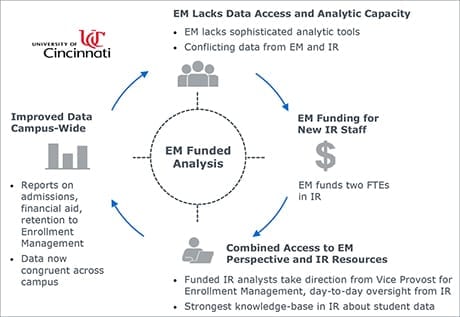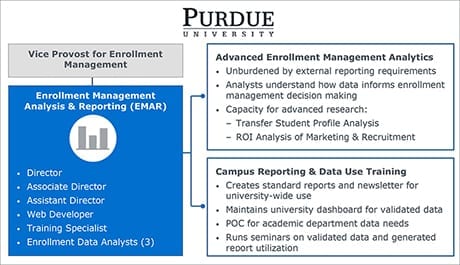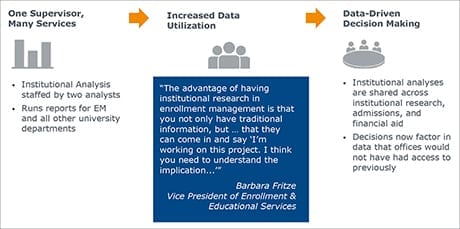Enrollment management (EM) hinges on the ability to harness data to inform strategic enrollment planning and day-to-day operations. Although EM divisions generate a wealth of data, many enrollment shops lack the staff and organizational oversight to analyze these data and remain reliant on Institutional Research (IR) departments.
The Problem: Plenty of Data, Limited Analytic Resources
Unfortunately, IR departments are so overburdened with regulatory reporting and compliance responsibilities that they often have little excess capacity. As a result, enrollment managers face:
- Inaccessible data lacking reliable and immediate access to up-to-date trends
- Campus data confusion resulting from different conclusions drawn from disparate data analyses
- Limited analytics capacity due to a lack of data and analytics expertise within the enrollment unit
The Solution: Organizational Models that Promote Data-Driven EM
Enrollment Management Forum research identified three organizational models facilitating a data-driven enrollment shop, while limiting the need for outsourced enrollment analysis. These models require varying degrees of enrollment manger time and resource allocation, from funding dedicated enrollment analysts within Institutional Research to establishing enrollment manager oversight over all IR operations and funding.

Model 1: EM-funded IR analysts
Funding enrollment analyst positions within IR requires the least structural change but the greatest cross-campus collaboration. This model works well at institutions facing IR overload but with an otherwise strong IR division. This was the case at the University of Cincinnati, where the enrollment manager’s team had less sophisticated analytics tools, software, and skill than IR, resulting in conflicting reports between the two divisions.

This organizational model yields three advantages for colleges and universities:
- Staff funded by Enrollment Management receive access to sophisticated analytics tools and are managed day-to-day by data experts
- Enrollment Management and IR reports no longer conflict
- Admissions, retention, and other enrollment data are seen as more credible and carry more weight coming from IR
Model 2: Internal EM analytics shop
Enrollment managers can also address IR overload by establishing a dedicated data and analytics unit within Enrollment Management. This model works well for enrollment management units with in-house data science experts.
Purdue University’s Enrollment Management Analysis and Reporting (EMAR) unit is dedicated full-time to conducting enrollment management analytics and providing training for faculty, deans, and other staff across campus on accessing EMAR reports and interpreting the data.

Advantages to developing an internal EM analytics shop include:
- EM possesses immediate access to data, analyses, and analytical capabilities without taxing the IR department
- Specialized knowledge of enrollment, admissions, and financial aid increases quality of enrollment analytics
- Campus requests for data are minimized due to increased cross-campus access to enrollment trend reports
Model 3: EM-IR integration
EM oversight of the IR unit requires the greatest organizational adjustments but maximizes EMs’ access to data and analytics. This is the model adopted by Gettysburg University, where the Vice President for Enrollment and Educational Services oversees Institutional Research as well as traditional enrollment management functions.

The key advantage of positioning IR within Enrollment Management is that the enrollment manager now possesses a more holistic understanding of campus trends due to the integration of different skills and data sets. For example, while analyzing results of an admitted student questionnaire, IR analysts recognized that it contained data about entering students’ online media usage. These insights helped the admissions marketing unit ensure that future media buys were closely aligned with student habits.
